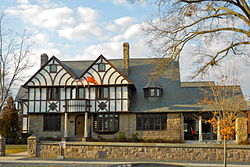Tiger Inn
|
Tiger Inn
|
|
 |
|
| Location | 48 Prospect Ave, Princeton, New Jersey |
|---|---|
| Coordinates | 40°20′56.2″N 74°39′08.2″W / 40.348944°N 74.652278°WCoordinates: 40°20′56.2″N 74°39′08.2″W / 40.348944°N 74.652278°W |
| Built | 1895 |
| Architect | G. Howard Chamberlin |
| Architectural style | Tudor revival |
| Part of | Princeton Historic District (#75001143) |
| Added to NRHP | 27 June 1975 |
The Tiger Inn (or "T.I." as it is colloquially known) is one of the eleven active eating clubs at Princeton University in Princeton, New Jersey. Tiger Inn was founded in 1890 and is one of the "Big Four" eating clubs at Princeton (the others are The Ivy Club, University Cottage Club, and Cap and Gown Club), the four oldest and most prestigious on campus. Tiger Inn is the third oldest Princeton Eating Club. Its historic clubhouse is located at 48 Prospect Avenue, Princeton, New Jersey, near the Princeton University campus. Members of "T.I." also frequently refer to the club as "The Glorious Tiger Inn." The club's unofficial motto is, "Always in the Right."
The Tiger Inn clubhouse is the oldest of the Princeton Eating Club houses. It is both architecturally distinct, built in the Tudor style, and historically notable. "The Clubhouse is designed in the timbered style of the 15th century and modeled especially after an old inn in Chelsea.". The clubhouse was built in 1895 for an original club membership of 30 undergraduates. The clubhouse has been in continuous use since the facility first opened. The architect for the clubhouse's original plan was G Howard Chamberlain. According to The Tiger Inn's official history, "Princeton myth [also] credits [the original plans for the clubhouse] to Howard Crosby Butler, Class of 1892 (a [Charter] member of Tiger Inn and Princeton's first Professor of architectural history)." The clubhouse's central hall was filled with massive antique furniture presented to the club by Mrs. T. Harrison Garrett; these furnishings remain in use to this day. The funding for the original clubhouse, the land, and the club's other furnishings were provided by the club's membership, although all at the time recognized the extraordinary support and contributions of the Garrett family.
Renovations to the clubhouse have continued since it was built in 1895. During 1922–1923 a room was added to the left of the front door and the second floor was remodeled; the second floor alterations were never used for their intended purpose as members quickly converted the new portion of the second floor space to a card room. In the fall of 1926 the clubhouse was substantially improved; during the six weeks of these alterations club members were required to take their meals at the surrounding clubs. By 1928 the kitchen had been moved to the south of the building. The changes to the clubhouse from 1926 to 1928 were well timed as this coincided with an expansion of the membership. The financing of the renovations placed Tiger Inn on the firm financial footing it would need to survive the Great Depression.
...
Wikipedia



